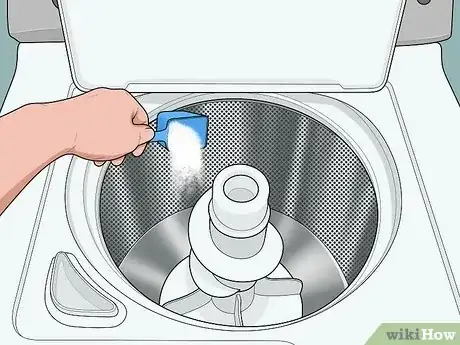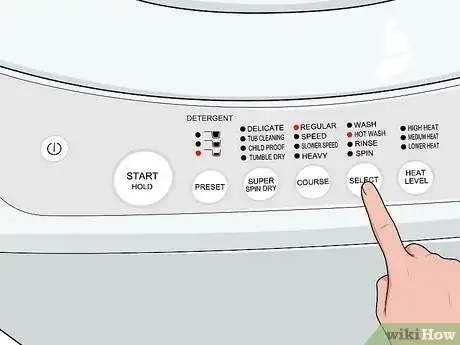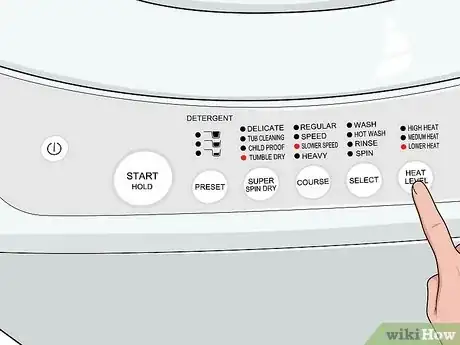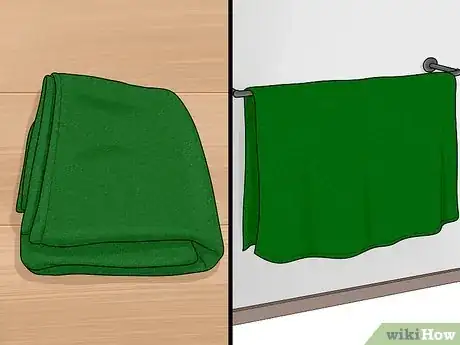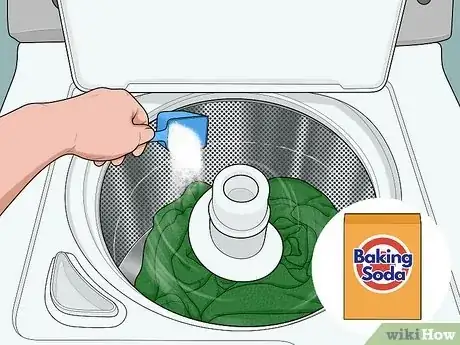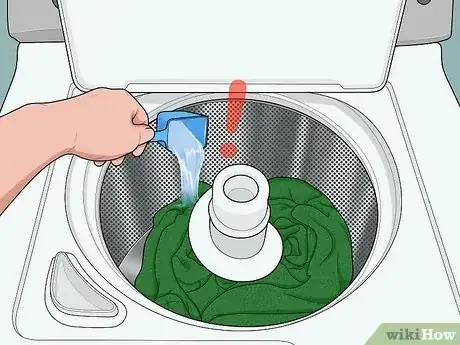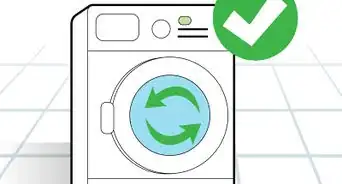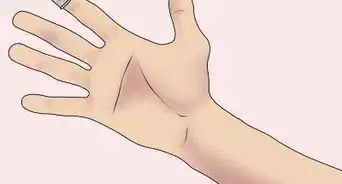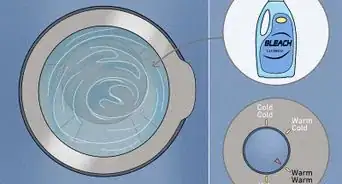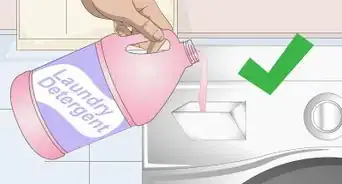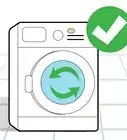This article was co-authored by Rani Gorgis. Rani Gorgis is a Laundry and Cleaning Specialist and the Owner of Park Blvd Laundry & Dry Cleaners in San Diego, California. With several years of experience in the laundry and cleaning industry, Rani specializes in dry cleaning, wash-n-fold, shirt laundry, and servicing smoke-damaged clothes. He holds a BS in Accounting and a CPA certification.
There are 8 references cited in this article, which can be found at the bottom of the page.
wikiHow marks an article as reader-approved once it receives enough positive feedback. This article received 11 testimonials and 100% of readers who voted found it helpful, earning it our reader-approved status.
This article has been viewed 194,253 times.
It's the curse of anyone who invests in a set of nice towels: after repeated use, they eventually become as rough and stiff as the rest of the towels in the bathroom. While it can be tricky to get towels back to their original level of fluffiness, several different tricks make it easy to restore a little softness to even the most worn-out towels. Best of all, these tricks are easy — all you'll need are your normal laundry supplies (plus a few common household ingredients if you want try some out-of-the-ordinary solutions).
Steps
Changing Your Laundry Habits
-
1Use less detergent. There are multiple reasons why a fluffy towel can become stiff. However, one of the most commonly cited reasons is the use of excessive detergent. Over time, the chemicals in detergents can build up in the fibers of the towel, making them stiffer and less absorbent.[1] To avoid this, use a little less detergent than you're directed to use for each load. This makes it slightly easier for your machine to wash the soapy residue away with each rinse cycle.[2]
- Don't be afraid to cut back on your detergent use. Odds are, you won't be left with dirty clothes — studies have shown that most Americans use more detergent than is necessary to get their clothes clean.[3] An added benefit of reducing your detergent use is that you will also save money!
-
2Give your towels "room to breathe" in the washer. If you're looking for fluffy towels, resist the temptation to stuff all of your laundry into a single load. To get the best results, you'll want to leave plenty of space in the washer for them so they can be properly rinsed and agitated.[4] This means:
- Using medium-small, manageable loads. Your machine should be about 1/2 full of loosely packed clothes. This goes for your dryer as well as your washer.[5]
- Washing your towels on their own (without other clothes in the load). In addition to crowding the washer, clothes with things like zippers and buttons can wear the fabric of the towels.
Advertisement -
3Use a hot wash (and a cold rinse). If your washing machine gives you the option to set different wash and rinse temperatures, use a hot wash followed by a cold rinse cycle. Many online sources recommend this. Hot water loosens the fibers of the towel and helps remove dirt, grime, and soap residue that can cause stiffness. Cold rinse water makes the fibers of the towel contract, making it less likely that they will "clump" together.
- Check the care label on colored towels before washing. Most whites will be safe for hot wash cycles, but hot water can make colored fabrics fade.
-
4Reduce the amount of tumble-drying you do. Tumble dryers can be a double-edged sword. While they make towels fluffier in the short term, repeated tumble-drying can wear down towel fabric, leading to towels that are less fluffy in the long-term. Luckily, there are several ways to avoid this problem:[6]
- Use gentler settings in your dryer — lower heats and slower speeds[7]
- Alternate between line-drying and tumble-drying.
- Line-dry towels, then "freshen them up" with a short cycle in the tumble dryer.
-
5Try adding towels to the washer after the detergent has dissolved. Some online sources stress the importance of knowing when to wash your towels — not just how to wash them. If you have a top-loading laundry machine, try adding a small amount of detergent, letting the chamber fill with water, and then adding your towels.[8] Avoiding direct contact between the detergent and the towels will help reduce the amount of soapy buildup and preserve the towels' fluffiness.
-
6Fold and hang towels for maximum fluffiness. Don't forget that the process of doing laundry doesn't end when the towels come out of the dryer. The way you fold and store your towels can also have some effect on their texture. Try using the tricks below to help keep your towels fluffy.
- Use loose folds to prevent stiff creases in the towel's fabric. Alternatively, loosely roll your towels. One good folding method is as follows:
- Hold your towel lengthwise (so that the short edge is pointing to the floor). Fold the towel in half to make a long, skinny strip.
- Loosely fold the towel into thirds. Fold one edge toward the center, then fold the other edge over the top and line up the edges so they form a tidy bundle.
- Fold the bundle in half once more and store the towel.
- Store folded towels side-by-side (like books) rather than in stacks. This helps prevent the bottom towels from being flattened by the ones above.
- If you're hanging towels from a rack, don't hang multiple towels on top of each other — this, too, can make the bottom towel stiffer.
- Use loose folds to prevent stiff creases in the towel's fabric. Alternatively, loosely roll your towels. One good folding method is as follows:
Using Unconventional Solutions
-
1Try using balls in your dryer. If you have towels that are already somewhat stiff, one way to soften them up is to throw a dryer-safe ball or two in the dryer with them. The repetitive action of the ball circulating with the towels will gradually "work out" any stiff spots, leaving you with softer towels. Commercial dryer balls can be found online or at many major department stores for reasonable prices — usually no more than about $5 per ball.
- If you want to save money, try throwing a few tennis balls in the dryer with your towels instead. These generally work just as well.
-
2Try adding vinegar to the wash cycle. Ordinary household white vinegar can help you get softer towels.[9] If you want to do this, add about 1/2 cup during the first rinse cycle (using more for large loads and less for small loads). This helps pull the soapy chemical buildup and hard water deposits out of the towel's fibers. You should notice softer towels after just a few cycles.
- Only use white vinegar for this task. Other vinegars, like apple cider and especially balsamic vinegar, can stain your laundry.
-
3Baking soda. Another good additive for getting your towels soft and fluffy is baking soda. Like vinegar, it will pull the grime and chemical buildup from the towel's fibers. As an added benefit, baking soda will also help remove odor from older towels.[10] Note, however, that baking soda can fade bright colors.
- Many online sources recommend against using baking soda and vinegar at the same time. These chemicals will react with and neutralize each other (just like in the famous "papier-mâché volcano" science fair project).
-
4Try borax or water-softening tablets. "Hard water" is water that contains a high amount of dissolved minerals.[11] When hard water is used to wash laundry, these minerals can build up and lead to stiffer fibers in the fabric of your towel. However, some "water-softening" products can reverse this effect. For instance, borax (sodium borate) is a safe, affordable laundry additive that can help reduce the mineral content in hard water and leave you with softer towels.[12]
- Borax is available online and in the "laundry" section of most major department stores for cheap — rarely more than $5 for a small box.
-
5Physically remove hard water from towels before drying. Don't have any borax handy? Try removing the hard water from your towels yourself. Gently wring the water from your towels over a sink or go outside and snap the towels to fling off excess water. The less hard water in your towels when they go into the dryer, the less mineral buildup you'll experience.
-
6Reduce your reliance on fabric softeners and dryer sheets. While fabric softening products may seem like a no-brainer, many sources actually recommend not using them for towels. While they can give soft, fluffy results in the short term, over time, the chemicals in these products can build up in the dense, interwoven fabrics of most towels (just like many detergents). Over time, these will make the towels stiffer and less-fluffy. This problem is worsened by using too-large loads and using too much product.
Community Q&A
-
QuestionWith a front load washer, where do I put the vinegar?
 Community AnswerYou can treat the vinegar as you would detergent or fabric softener. As long as it goes into the wash, it will do its job.
Community AnswerYou can treat the vinegar as you would detergent or fabric softener. As long as it goes into the wash, it will do its job. -
QuestionWhich detergents do not have optical brighteners in them?
 Community AnswerIf you're in the UK, most "colour care" detergents don't have them. Try Ariel Colour or Persil Colour. If you're in the U.S., try brands like Woolite and Cheer. Eco-friendly detergents also do not contain optical brighteners.
Community AnswerIf you're in the UK, most "colour care" detergents don't have them. Try Ariel Colour or Persil Colour. If you're in the U.S., try brands like Woolite and Cheer. Eco-friendly detergents also do not contain optical brighteners. -
QuestionWhere do I put the white wine vinegar when washing towels?
 Community AnswerOnce there is a little bit of water in the bottom of the washing machine, I add my detergent, then my vinegar. Then I let the water fill a little more, and then put my laundry in.
Community AnswerOnce there is a little bit of water in the bottom of the washing machine, I add my detergent, then my vinegar. Then I let the water fill a little more, and then put my laundry in.
References
- ↑ Rani Gorgis. Laundry & Cleaning Specialist. Expert Interview. 7 April 2021.
- ↑ https://turkishtowelcompany.com/how-do-i-keep-towels-soft#.VQcbfOGzlnR
- ↑ http://www.wsj.com/articles/SB10001424052748703808904575025021214910714
- ↑ Rani Gorgis. Laundry & Cleaning Specialist. Expert Interview. 7 April 2021.
- ↑ http://www.mamaslaundrytalk.com/laundry-basics-size-of-loads-and-starting-the-washer/
- ↑ http://turkishtowelcompany.com/how-do-i-keep-towels-soft#.VQcbfOGzlnR
- ↑ Rani Gorgis. Laundry & Cleaning Specialist. Expert Interview. 7 April 2021.
- ↑ http://www.overstock.com/guides/how-to-keep-towels-fluffy-and-soft
- ↑ Rani Gorgis. Laundry & Cleaning Specialist. Expert Interview. 7 April 2021.
About This Article
If you want to get fluffy towels, wash them in a separate, medium-sized load with a hot wash and a cold rinse, if your machine has a setting for that. Use a little less detergent than the label calls for, since soapy residue can make your towels feel stiff. After you have washed your towels, dry them on a low heat setting to help preserve their fluffiness over time. For extra fluffy towels, place a dryer-safe ball in with your towels as you’re drying them. Keep reading to learn how laundry additives like baking soda, borax, and vinegar can make your towels fluffy!
